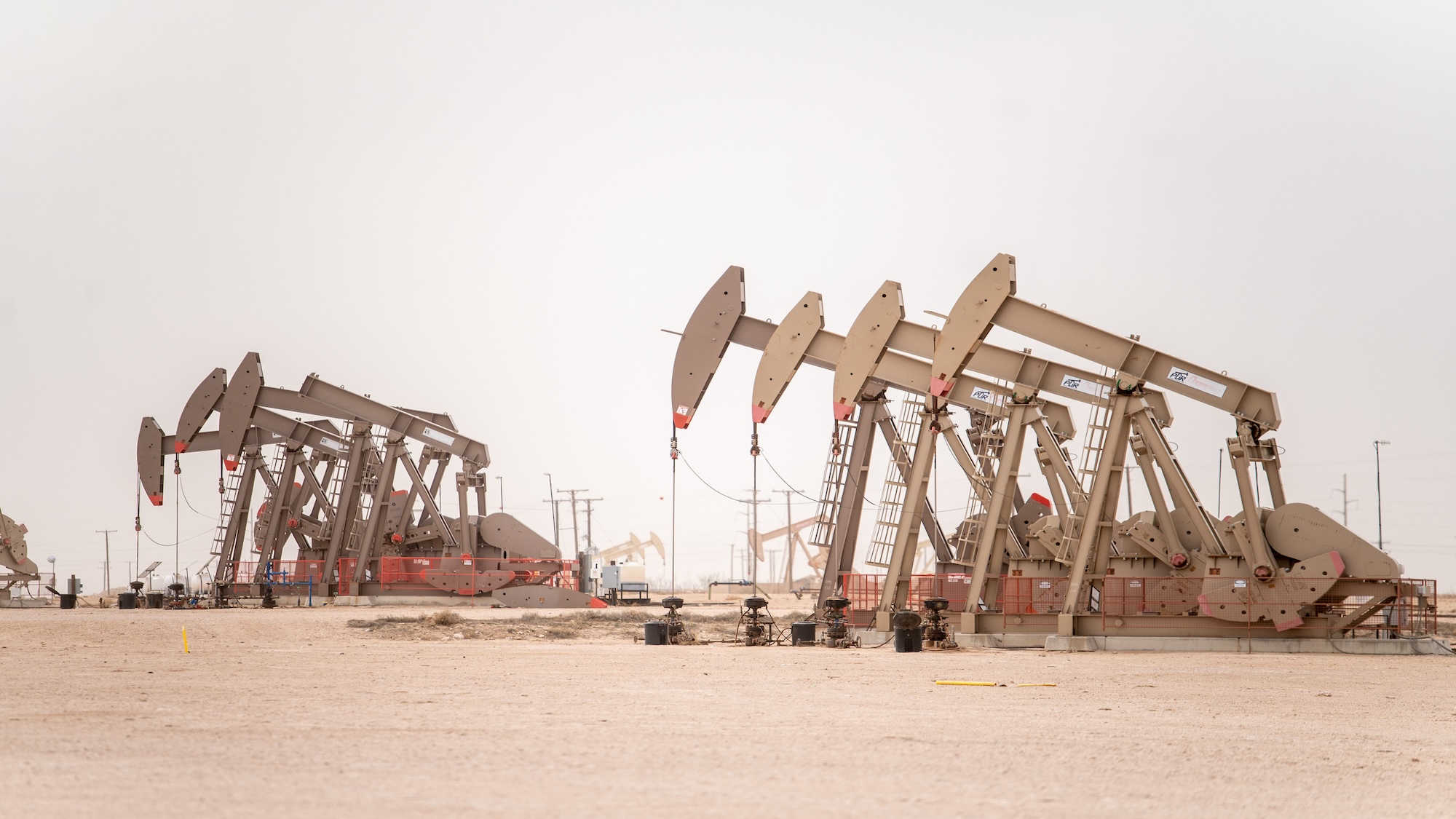Oil price posts two-year highs - but how long can it last?
Brent rose above $59 a barrel this week, its best third-quarter showing since 2004

Oil price tops $60 as fighting breaks out in Libya
03 March
The oil price rebounded by more than $2 towards $62 a barrel today following reports of fierce fighting between Libyan rivals around oil terminals. Stronger equity markets and improved demand also helped Brent futures to recover from their biggest one-day loss in a month.
On Monday, Brent crude fell by almost 5 per cent due to ongoing concerns among traders about the growing global oil glut, but the market rebounded today due to concerns over the future of Libya's oil capacity.
The Week
Escape your echo chamber. Get the facts behind the news, plus analysis from multiple perspectives.

Sign up for The Week's Free Newsletters
From our morning news briefing to a weekly Good News Newsletter, get the best of The Week delivered directly to your inbox.
From our morning news briefing to a weekly Good News Newsletter, get the best of The Week delivered directly to your inbox.
Libyan forces were involved in "tit-for-tat air strikes" on oil terminals and an airport this morning, Reuters reports, prompting fears about the Opec member's ability to keep up the supply of oil. The news had an immediate effect on the market, pushing the price of Brent up past $60.
Oilfields are "increasingly a target" for rival forces in Libya attempting to fill the power vacuum left after the ousting of Muammar Gaddafi in 2011. Forces claiming allegiance to Islamic State have also begun targeting oilfields and pipelines, Reuters said.
The rising price was also fuelled by a resurgent yen which, in knocking the US dollar off an 11-year high, helped to make commodities priced on the US dollar –including oil – more appealing to holders of other currencies, CNBC reports.
A drop in the number of operating US rigs has also been boosting oil prices, and some analysts believe that the low oil prices could now be beginning to stimulate the market. "The low prices have helped demand, and that has supported the crude oil market," said Olivier Jakob of PetroMatrix.
A free daily email with the biggest news stories of the day – and the best features from TheWeek.com
However, according to ABN AMRO senior energy economist Hans van Cleef, the global oil glut will continue to keep prices low. "Oversupply is still an issue," van Cleef said, "and this caps the upside potential of oil prices in this supply-driven market".
Oil price rises ahead of key US oil rig data
27 February
The oil price rallied on Friday ahead of the release of key US data that is predicted to show a reduction in drilling.
Crude futures have been volatile over the past few weeks as the market attempted to weigh the possibility of US supply cuts against a continuing excess of supply elsewhere in the world, Fox reports.
Brent, the global oil price benchmark, has risen by more than 13 per cent in February while West Texas Intermediate remained largely flat.
New data is expected to be delivered later today by oilfield-services firm Baker Hughes, on the latest count of rigs operating across the US.
Drillers have been "idling rigs" at a record pace, Bloomberg reports, laying off thousands of workers and shutting down operations.
The number of rigs operating in the US has reportedly fallen by more than 35 per cent since October. There are now 1,019 US rigs drilling for oil, the fewest since July 2011. Oil explorers such as Royal Dutch Shell and Chevron say they have cut costs by $50 billion since 1 November last year.
The closing of rigs shows that Saudi Arabia's strategy of maintainin Opec's output levels to protect its market share is "paying off", Bloomberg says.
"It is having the effect that we would expect," says Francisco Blanch, head of commodities research at the Bank of America, "which is a decline in investment and ultimately supply, and somewhat higher demand."
The International Energy Agency, a Paris-based energy policy advisor, says that world dependence on oil from Opec nations is set to increase due to lower production forecasts from other nations.
The slightly weaker US dollar also helped to buoy oil prices on Friday, Fox says. "As oil is priced in dollars, it becomes more attractive to holders of foreign currencies when the greenback depreciates," the network says.
Oil price plunge could hit UK jobs after 'bleak' 2014
24 February
The UK oil and gas industry has reported its worst annual performance in 40 years, after the oil price plunged in the second half of 2014.
Oil & Gas UK, which represents energy companies, said the sector invested £5.3bn more than it earned from sales last year. Rising costs also contributed to the shortfall.
It said that the results posed a serious challenge to the future viability of the industry, The Guardian reports.
The cost of producing a barrel of oil has risen to a record high of £18.50, on top of investment, tax and decommissioning costs, the group said. Simultaneously, the falling oil price – which dipped below $50 a barrel earlier this year – cut revenues to just over £24bn for the year. That was the lowest since 1970.
Malcolm Webb, chief executive of Oil & Gas UK, said thousands of jobs were in danger unless taxes were cut and new incentives offered.
"Without sustained investment in new and existing fields, critical infrastructure will disappear, taking with it important North Sea hubs, effectively sterilising areas of the basin and leaving oil and gas in the ground," Webb said.
Opec is currently considering calling an emergency meeting to address the ongoing fluctuations in the oil price.
The Opec president, Diezani Alison-Madueke, said further volatility would make it "highly likely that I will have to call an extraordinary meeting of Opec in the next six weeks or so".
Oil price turbulence: will it climb to $100 or drop to $10?
23 February
The oil price fell again today after a week of small gains and losses in which a barrel of Brent crude hovered around the $60 mark.
A strengthening dollar and concerns about long-term oversupply offset reduced output due to freezing weather and industrial action in the US, Reuters reports.
But the oil price remains at little more than half its peak in June last year, and some analysts predict it may yet fall far lower. Others claim the price has now bottomed out.
Last week, Bloomberg's A. Gary Shilling predicted the possibility of oil at $10 per barrel – a far cry from the predictions of T. Boone Pickens, who towards the end of last year anticipated a return to an oil price of $100 within 12 to 18 months.
So, who is right?
The answer, according to Martin Tillier from Oilprice.com is neither. "As with most things in life", Tillier says, "it is unlikely that the truth lies at either extreme" but rather, somewhere in the middle.
There are good reasons why such predictions exist, though.
As an oil investor, Pickens has "a massive stake in driving oil higher however he can", Tillier says, while, Shilling is "in the business of garnering eyeballs and clicks", which could explain his extreme prediction.
As dull as it is to predict steady gradual change, the most likely scenario is that prices will hover around their current levels, Tillier says, before "gradually recovering to the $60-$70 per barrel level".
We shouldn't be surprised that "publicity hungry columnists and heavily invested oilmen" are predicting further wild swings, but we should be wary of both, Tillier concludes.
Oil price falls again – and 'could hit $10 a barrel'
19 February
The oil price slipped downwards again this morning, losing more than $2 or almost four per cent, as markets prepared for data expected to show rising output from US wells.
Brent crude was trading at $58.85 a barrel at 11.30am, down from a two-month high of $63 on Tuesday.
The plunging oil price had gone into reverse in the previous two weeks, prompting some traders to suggest that the oil market had reached a bottom. But according to new analysis by Bloomberg, oil prices could be set to fall sharply again and could even reach $10 per barrel.
In his report, A. Gary Shilling argues that a combination of factors will push the oil price down again.
The first is the diminishing power of the Opec cartel. In Shilling's view, Saudi Arabia has experienced market-share losses in the past, due to the "cheating" of fellow cartel members, who have exceeded their agreed output quotes.
Consequently, Saudi Arabia has embarked on a "game of chicken" with the cheaters, believing that it can withstand low prices for longer than its financially weaker competitors.
The latest figures suggest that Saudi oil production has now increased to 10m barrels per day, and data out later today is expected to show that US oil output is also on the increase.
"According to the American Petroleum Institute, US crude stocks rose by 14.3m barrels last week, far more than analysts had expected, The Guardian reports. "Markets are waiting for official figures from the US Energy Information Administration, out at 16.00 GMT. If they confirm the large build-up in inventories, it would be the biggest weekly increase since data started in 1982.
Some analysts had predicted that the falling oil price would act as a brake on production, especially in the US, where extraction costs are higher.
But Shilling points to research by Daniel Yergin from the energy consultant IHS Cambridge Energy Research Associates, which suggests that most oil producers can weather prices much lower than the average cost of production.
He says they are likely to cut production only when the oil price falls below the "marginal cost of production", which effectively covers the extra costs that exist "after the wells are drilled and the pipes are laid".
According to research by the energy research organisation Wood Mackenzie, only 1.6 percent of the 2,222 oil fields they surveyed around the world are likely to have negative cash flow at $40 a barrel. Consequently, Shilling says that the marginal cost for both US shale-oil producers and oil producers in the Persian Gulf "is about $10 to $20 a barrel".
Finally, as supply continues to rise, Shilling notes that global demand is receding. The International Energy Agency has been slashing its forecasts for global oil demand growth for months, the International Business Times reports. The agency's 2015 global demand forecast now sits at 93.3 million barrels a day, while supply is likely to exceed this demand by 400,000 barrels a day.
To Shilling's list, the Daily Telegraph adds another critical factor – the growing productivity and efficiency of the US oil industry, which has seen annual increases in productivity per rig in excess of 30 per cent. "If significant gains in productivity can be achieved in other types of production, it may lead to a sustained fall in the relative price of oil", the Telegraph says.
The net effect will be not only "big declines in crude oil" prices, Shilling concludes, but related energy prices as well.
-
 Zimbabwe’s driving crisis
Zimbabwe’s driving crisisUnder the Radar Southern African nation is experiencing a ‘public health disaster’ with one of the highest road fatality rates in the world
-
 The Mint’s 250th anniversary coins face a whitewashing controversy
The Mint’s 250th anniversary coins face a whitewashing controversyThe Explainer The designs omitted several notable moments for civil rights and women’s rights
-
 ‘If regulators nix the rail merger, supply chain inefficiency will persist’
‘If regulators nix the rail merger, supply chain inefficiency will persist’Instant Opinion Opinion, comment and editorials of the day
-
 How might the Israel-Hamas war affect the global economy?
How might the Israel-Hamas war affect the global economy?Today's Big Question Regional escalation could send oil prices and inflation sky-high, sparking a worldwide recession
-
 Recent mega-mergers could signal a turning point for the US oil industry
Recent mega-mergers could signal a turning point for the US oil industryTalking Point Both Chevron and Exxon have recently spent billions to acquire smaller oil companies
-
 Has Saudi Arabia lost control of oil prices?
Has Saudi Arabia lost control of oil prices?Today's Big Question Kingdom goes it alone to cut production, risking tension with US and reigniting cooling inflation in Europe
-
 US angered by Opec+ oil cut
US angered by Opec+ oil cutSpeed Read Energy prices to rise further as producers slash supply by two million barrels a day
-
 Global oil demand forecast lowered for 2020 and 2021
Global oil demand forecast lowered for 2020 and 2021Speed Read IEA report says jet fuel demand remains the major source of weakness
-
 Are US-Iran tensions flaring again?
Are US-Iran tensions flaring again?In Depth Trump threatens military action over Twitter
-
 Can a deal be struck to raise oil prices?
Can a deal be struck to raise oil prices?In Depth Opec+ will convene today over video link in a bid to boost crude
-
 What do negative oil prices mean?
What do negative oil prices mean?In Depth Perfect storm of oversupply and storage shortages sees producers paying to get rid of US crude